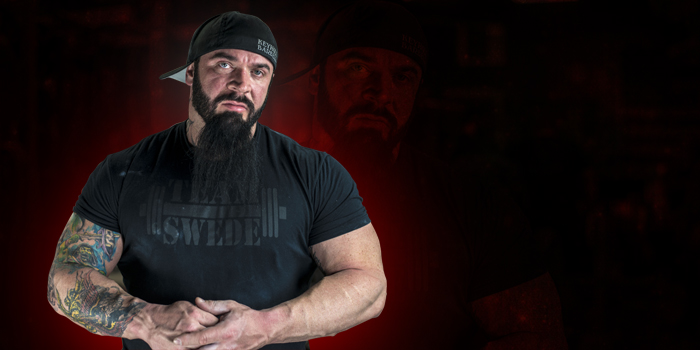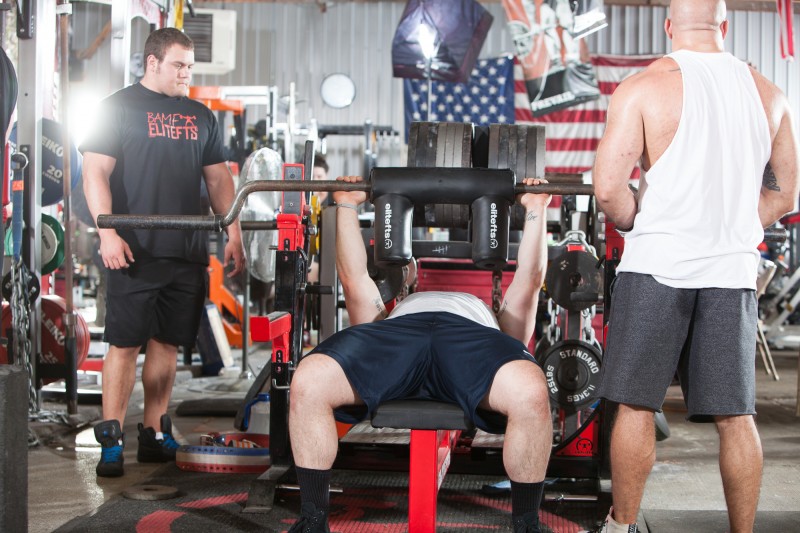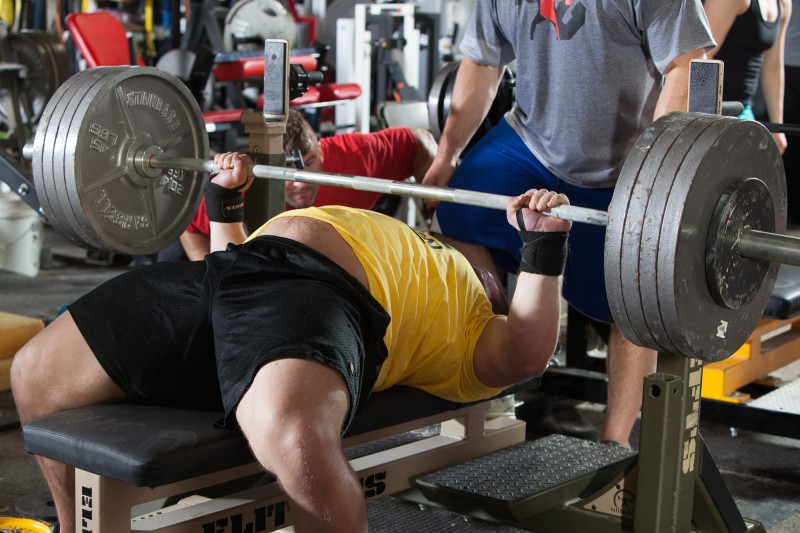
I'm sometimes asked questions, the answers to which are too complex for me to effectively cover in passing conversation; or to type out, again and again, to each person who messages me. So I will usually draw the asker's attention to the fact that I've written several really thorough books on these subjects, books which do answer everything they are asking me, usually in great detail.
But some people are broke or they have no sense of logic or priority, or work crazy hours and have kids or some other obstacle which makes purchasing and reading a book an endeavor all its own. It is what it is. Those people need help, too. I've been a member of that group in the past. This is the chief reason I've provided over 100,000 words of content via my column, here.
RECENT: An Argument for Specificity
These articles provide bite-sized, easy to chew bits of information; Cliffs Notes, if you will, on specific powerlifting related topics, free of charge. More than that, when people ask the type of question I was referring to earlier, I am able to provide a complete answer by simply linking them to the appropriate article. How convenient is that?
(It's pretty fucking convenient.)
Today I'm going to cover a few common questions regarding assistance work and the concept of the "law of accommodation"; and finally, identify the use of bands, chains and specialty bars for assistance work.
One of the more common questions I get regards how and when assistance exercises, and the protocols used for them, should be changed or rotated, both in general and specifically when using the 5thSet methodology. This is such a popular point of confusion, due to a pervasive misconception which finds its roots in what is usually referred to as the "law of accommodation," more precisely the ham-handed approach some popular methods of training use to address said "law."
To answer this question we need to get to the root of that misconception. The problem is not with the law, itself, but rather how the potential obstacles it presents are usually handled. Or, I should say mishandled.
The law of accommodation states, what is essentially a reiteration of some of Prof. Yuri Verkhoshansky's early writing, that a training means can lose its potential over time.
Now, a "training means" is defined as any exercise performed according to a given system or protocol. So, Triceps Extensions, performed for a hypertrophy protocol, or let's say three sets of twelve repetitions, would be considered a training means.
I should also explain that the term "training potential" is defined as the limit of efficacy for a given "training means" or system. So, if you were to perform those triceps extensions, using that hypertrophy protocol over a very long period of time, that training means would probably work well for awhile and then eventually, gradually become less effective. This is pretty simple stuff, right?
Maybe not.
Somewhere, someone decided (won't point any fingers, here) that the solution to the problem presented above was to change the training means a given lifter would use every few weeks; in some cases every week. Eventually, the idea became accepted that the training means, itself, was less important than the fact that the means was changed, and frequently. (Unfortunately, this is categorically untrue.)
Things progressed to the point where exercise selection for many became arbitrary, to the tune of "What variation do you feel like doing for squat today?" (It doesn't matter what you feel like, by the way, in case I've ever been unclear about that.)
The situation I described above probably sounds familiar to you, but it presents far more problems than it solves.
- Arbitrariness has no place in your training.
- The training potential for a training means actually increases over time before it begins to gradually decline (think months, not weeks). So, if you're changing your training means every week or every three weeks, you're never getting nearly what you could from any of them.
- If the subsequent training means used does not possess a greater training potential than the means used prior to it, it will not be effective. Read that again. This is why we don't just start with, and rotate into, all of the training means with the highest training potentials. A) The cost/return ratio would be devastating. B) The roads from there don't take you anywhere you'd really want to go. That is unless you're into doing different exercise variations and rep schemes without really getting much bigger or stronger.
Here we see the problem with randomness: it sets up the lifter to stall out, and much sooner than they need to.
Understanding all of this, what is the best solution? Don't worry, dear reader, I would not drag you this far to leave you hanging.
If you've read my most recent article, you know my stance on specificity for the powerlifter — that the lion's share of focus or volume load should be dedicated to the competition lifts and, furthermore, this type of specificity should be honored year round. You'll probably also remember that specificity in terms of training intensity is something which becomes more of a priority as a powerlifter gets closer to competition. So with all this, we can see that first, we should limit exercise selection for our "main work" in order to honor the year-round demand for specificity, which leaves us with only intensity and volume load as modifiable factors to change the training means.

Given what we've just learned, it seems like we would want to start with intensity lower for the main work and move on to gradually more intense means throughout each training cycle. The 5thSet protocols do a very good job of that within the course of a mesocycle. From a high-level overview, we'd see the same is true throughout the course of an entire macrocycle (about six months).
So far, this is all pretty cut and dry. But things get a little more complicated when we look at how assistance work will fit into this picture. On the bright side, since we've already met our requirement for specificity via the volume load and intensity prescribed in the main work, the door is now open to address the second half of the questions I will answer with this article: how specialty bars, bands, and chains can be used as an effective piece of the 5thSet methodology puzzle. Or the puzzle of any method of training for the sport of powerlifting, for that matter.
Assistance work should be broken into two overarching groups, one being significantly more impactful than the other. The first and most important group would be secondary movements, which are referred to as MSM's or "Mechanically Similar Movements" when operating within the confines of the 5thSet methodology (which every powerlifter should be doing). A good example would be performing board presses as an MSM for bench press, after the main work. The second group would consist of both compound and isolation exercises which are not similar to the competition movements.
Since we have more freedom in selecting exercises here, we can begin to effectively implement those specialty bars and even the bands and chains I'm so often asked about. But how?
Accepting that the initial training means used must over time be exchanged for those with greater training potential, we can see that we must start with something which may have only a moderate training potential. These training means can be used to develop characteristics, like hypertrophy, which will support the development of other goal characteristics, like maximal strength, via the use of an enhanced or more intense training means in a subsequent mesocycle.
If we plan everything out correctly, we will use the means with the highest potential in the mesocycles just prior to competition. After competition, we can very easily reset our MSM's back to a moderate training means and begin the process of this sequence once again.
Specialty bars can be used as excellent choices for MSM's for the competition lifts. The Safety Squat Bar, for example, can be used as an excellent MSM for squats and performed after the main work in that session. These can be used and rotated according to the needs of the lifter throughout the course of a macrocycle with respect to the need for a gradually increasing training potential.
WATCH: Table Talk — Should You Train Assistance Movements to Failure?
To be clear, I believe accommodating resistance devices like bands and chains can be used to create training means which possess the absolute highest training potentials for the powerlifter. But there is a time and place for that, and in my opinion that rests within a peaking mesocycle, immediately prior to competition.
My MSM sequence system was built, and operates, upon the axiom that any training means does, in fact, lose it training potential eventually; and so, should be replaced in sequence with training means with gradually higher training potentials. But it also addresses the fact that the training potential of a training means takes time to develop.
This is all covered in the 5thSet Evolutions book in detail like I said, but these general principles and the information I've laid out here can be applied to any method of strength training.
Sooner or later we've all got to wrestle with the ghosts of our own failing identities as lifters. We all will reach a point where further progress becomes, or at least seems, impossible. I don't know about you, but I'd much rather do that later than sooner. Sequencing assistance work in the manner I've described is one tool to help make sure that will be the case.











